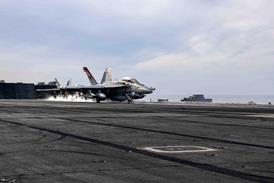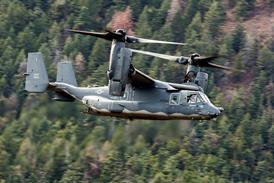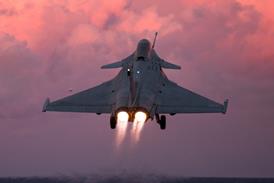Moscow's fast-growing and newly modernised second airport Domodedovo believes it represents the future and has already started to win over new international operators
Moscow Domodedovo's gate guardian, a once-mighty Aeroflot Tupolev Tu-114 that stands on permanent watch beside the entry road, is the airport's only concession to the past. Beyond this historic symbol of 1950s Soviet aviation lies a polished, glassy structure that strips away the commonly held prejudice of Russian architecture as a concrete-block industry. Until a few years ago a dilapidated relic of the Cold War, Domodedovo easily matches the image of a modern Western airport. Hardly surprising, then, that its management company, the East Line Group, believes it represents Moscow's future.
No fewer than 24 airlines have switched to using the airport in the past three years, defecting largely from the congested main Sheremetyevo International Airport as well as Moscow's third airport, Vnukovo. Of the three airports, Domodedovo now deals with at least one-third of Moscow air traffic, and more than half of all freight.
May 2002 saw Russia's second-largest carrier, Sibir, consolidate its scheduled operations at Domodedovo, having moved its charter services there a month before. Sibir has joined some of the better-known Russian carriers such as KrasAir, Transaero, Pulkovo Airlines and the newly-renamed UTAir, formerly Tyumenaviatrans.
But even more crucially, three of the airlines to transfer services - Air Malta, Adria Airways and Swiss - are international flag-carriers from outside Russia and the CIS. Belgium's Sabena had intended to shift its own flights to Domodedovo in a bid to cut costs before the airline's collapse in late 2001, and British Airways is also seriously considering turning its back on Sheremetyevo.
Each decision to move is a resounding endorsement of East Line, says Moscow Domodedovo general director Sergey Rudakov, and it wants to keep up the momentum. "Every day we are trying to attract to our airport more foreign airlines. We want to conduct negotiations with good, reliable foreign carriers."
Domodedovo's attractions are clear. Its renovated terminal building is clean and brightly-lit, conveying a sense of order and spaciousness, unlike the dingy chaos of Sheremetyevo with its outdated copperpot ceiling and shops that appear to have been crammed in as an afterthought. Wooden signs above check-in desks and electromechanical displays at Sheremetyevo are replaced by plasma-screen technology at Domodedovo.
Rudakov says the single terminal, split between domestic and international operations, gives it the ability to handle transfer passengers easily, unlike Sheremetyevo. East Line has brought in automated transfer systems, and security controls include 100% baggage screening.
The airport is also the only one in Moscow with a rapid-transit rail link. Its Aeroexpress train, operational since August 2002, leaves from a platform adjacent to the terminal and takes 40mins to travel to the city's Paveletsky station. Moscow's notorious traffic means two-hour road journeys from Sheremetyevo are not uncommon.
"We have other important advantages," says Rudakov. "Because we have a private group as the owner and operator, each company flying to Domodedovo has contact with only one enterprise."
East Line says airlines can effectively negotiate a complete service package at Domodedovo, where charges are 20-30% lower than at rival Sheremetyevo.
Practically all airport operations at Domodedovo are divided into individual East Line business units - ground handling, fuelling, catering, and so on - employing 9,500 people. East Line defends this monopoly, pointing out that Domodedovo receives no government funding. The airport is self-financing and the company reinvests heavily, spending $350 million so far to expand and improve the infrastructure.
"Our passenger terminal, for example, is not very profitable," says Rudakov. "If we want to fund expansion, it would be impossible from the terminal alone. But because we're in catering, cargo and other areas, it allows us to consolidate income from the whole group."
Domodedovo expects 8 million passengers in 2003, double the 2001 figure, pushing it to the limits of capacity. To avoid being suffocated by its own success and ensure space is available for new airlines, East Line aims to complete a new airport expansion phase before summer this year to increase capacity by 30%.
This centres on the construction of two large piers, one international and one domestic, each with 11 airbridges. Most airlines currently have to use the vast parking apron.
Refurbishment of the control tower is under way and East Line is co-operating with Boeing to establish a maintenance division, East Line Technik, for Western-built aircraft to complement its Russian aircraft facilities, and plans to house the operation in a separate hangar. JAR145 maintenance certification is expected in February. East Line engineers are already being trained in Seattle.
The airport's parallel 3,500m and 3,794m runways are spaced about 2,000m apart, enabling it to conduct simultaneous independent operations - a flexibility denied to the closely-spaced parallels at Sheremetyevo.
East Line plans to begin reconstructing one of the runways before 2004, keeping at least a 2,000m section open at all times so as not to disrupt operations. Russia's government owns the runways - originally designed for military requirements and easily capable of handling the largest commercial traffic - and has been persuaded to contribute $4 million from its state budget to the project.
"I need a lot of permission and have to go a sophisticated route to invest even one dollar in governmental property here," says East Line chairman Dmitry Kamenshchik.
European Union studies have concluded Domodedovo should evolve as Moscow's future gateway and Kamenshchik is laying the ground work to turn Domodedovo into a 100 million-passenger super-hub over the next 30-40 years.
Medium-term expansion will probably see the international wing double in size in five to seven years, with an additional pier, followed closely by a similar extension of the domestic wing. East Line envisions a third and fourth runway, but Kamenshchik says the company is reserving 650km2 (250 miles2) of surrounding land to ensure its long-term expansion - including up to 10 runways - will not hit environmental problems.
Moscow expansion
Rival Sheremetyevo's expansion plans have yet to be decided. Its much-discussed third terminal, dedicated to Aeroflot operations, is seen as vital to the Russian flag-carrier's strategy to bind itself to the SkyTeam alliance. But the $300 million Sheremetyevo-3 project is far behind schedule. In November, the airport's management board fired Sheremetyevo director Sergei Belyayev and installed a new chief in a bid to kick-start the terminal programme.
Sheremetyevo-3 will handle 10 million passengers a year but is not expected to open until 2005. In the near term, it is preparing to expand its international Sheremetyevo-2 terminal, increasing capacity by 3 million passengers.
East Line could become Russia's answer to Western private airport operators such as Fraport, BAA, Flughafen Wien and Schiphol Group. Although the company has declined one potential opportunity to get involved in airport management outside Domodedovo, Kamenshchik says: "In Russia we are considering a few such projects."
As to whether Domodedovo will ultimately become the capital's gateway, Kamenshchik is content to let airport evolution take its natural course. "We're planning to develop this airport as well as we can, as quickly as we can," he says. "My business aim is to develop Domodedovo, not to close Sheremetyevo."
David Kaminski-Morrow is European regional reporter for sister online news service Air Transport Intelligence.
| Top 10 carriers at Domodedovo | ||
| Airline | Share | |
| 1 | Sibir - Siberia Airlines | 24.3% |
| 2 | Domodedovo Airlines | 14.8% |
| 3 | Transaero | 11.0% |
| 4 | Imair | 4.3% |
| 5 | Krasnoyarsk Airlines | 3.9%. |
| 6 | Swiss | 3.7% |
| 7 | Bashkir Airlines | 3.3% |
| 8 | Utair Aviation JSC | 3.3% |
| 9 | Tatarstan | 2.8% |
| 10 | Ural Airlines | 2.6% |
| Note: Share of flights by leading carriers at December 2002 | ||
| Moscow airport system analysis of services - OAG December 2002 | ||||||
| Airport | Weekly flights | Service distribution by destination | ||||
| number | share | Russia | Other CIS | W Europe | E Europe | |
| Sheremetyevo | 1,050 | 54.6% | 36.5% | 9.6% | 33.6% | 9.5% |
| Domodedovo | 566 | 29.5% | 66.5% | 24.3% | 6.2% | 0.6% |
| Vnukovo | 300 | 15.6% | 69.4% | 27.0% | 1.4% | 0.0% |
| TOTAL* | 1,923 | 99.6% | 50.7% | 16.6% | 20.4% | 5.4% |
| NOTE: Analysis of return scheduled weekly flights for December 2002, including cargo services, from OAG schedule data. Russia= Russian Federation CIS= includes Armenia, Belarus, Ukraine, the 'stans' etc E Europe= non-CIS Eastern Europe. TOTAL*= includes 7 weekly flights at Bykovo Airport | ||||||
REPORT BY DAVID KAMINSKI-MORROW IN MOSCOW
Source: Airline Business


























